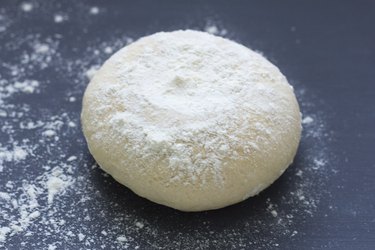
There are several ways to grease a pizza pan before baking, such as adding oil or butter. Keep in mind that whatever you use will also transfer to the pizza dough, so you might want to choose a healthy option.
Prepare a Delicious Homemade Pizza
Video of the Day
Buying pizza from a restaurant saves time, but it's costly and not necessarily healthy. Store-bought pizza is often high in fat and sodium and may contain processed ingredients.
Video of the Day
Luckily, it's easy and cheap to make pizza at home. You can buy dough from the store, either frozen or fresh, and make the crust yourself.
Once you have your dough, place it in a baking pan. But before you do this, make sure you grease the pan. That's the best way to prevent the dough from burning or sticking to the pan once it's done cooking.
Read more: 7 Healthier Pizza Recipes to Make at Home
You can use a tablespoon of oil to grease the pizza pan and prevent sticking. Olive oil is a good choice, but it might not work for other foods, such as desserts. Its distinctive flavor works well with pizza.
Olive oil is known as a healthier alternative to butter and margarine because of its high content of antioxidants and unsaturated fats. A February 2019 study published in Frontiers in Nutrition explains that replacing saturated fats from butter and other animal products with the unsaturated fats in olive oil benefits overall health. For example, it may help increase HDL cholesterol, which is considered the "good" cholesterol.
A tablespoon of olive oil provides 119 calories, according to the USDA. It also supplies 13.5 grams of fat, but there are no other macronutrients. However, olive oil does contain small amounts of vitamins and minerals.
Alternative Grease for Baking Pans
Many chefs prefer using margarine or butter to grease a pan before baking. Between butter and margarine, butter was initially thought of as the worse option to grease a pan, but Harvard Health Publishing explains that margarine contains trans fats, making it less healthy. However, there are healthier versions of margarine available, so make sure you check the labels.
One tablespoon of butter contains 100 calories. It has 11 grams of fat and large amounts of vitamin A. There are fewer vitamins and minerals in butter than in olive oil, though.
While butter has gotten a bad rap, it might not be as harmful as you think. A June 2016 study published in PLOS One, an open-access peer-reviewed journal, has found that there were either minimal or no increases in the risk of cardiovascular disease or mortality in people who consumed this kind of fat. While the study doesn't write off butter as a possible health risk, it's likely safe to use it occasionally in small quantities.
Read more: How to Cook Whole Foods Pizza Dough
If you want to avoid fat altogether, you may use cornmeal on the pizza pan instead. It doesn't contain any of the extra fats that oil, butter or margarine have. The Institute for Culinary Education suggests using two teaspoons of salt cornmeal to dust the dough.
A quarter cup of cornmeal contains 150 calories, reports the USDA. It also has 34 grams of carbs and no other macronutrients. While using cornmeal to grease your baking pan will up the carb count of your pizza, it reduces the fat content compared to using oil, butter or margarine. For a healthier version, try our Avocado Pizza recipe, which is low in carbs and packed with healthy fats.
- PLOS One: "Is Butter Back? A Systematic Review and Meta-Analysis of Butter Consumption and Risk of Cardiovascular Disease, Diabetes, and Total Mortality"
- USDA FoodData Central: "Butter"
- Harvard Health Publishing: "Butter vs. Margarine"
- Frontiers in Nutrition: "Network Meta-Analysis of Metabolic Effects of Olive-Oil in Humans Shows the Importance of Olive Oil Consumption With Moderate Polyphenol Levels as Part of the Mediterranean Diet"
- USDA FoodData Central: "Olive Oil"
- Institute of Culinary Education: "Homemade Pizza Tricks You'll Want to Steal"